”… about the boom in political satire in France. On that subject, you might remember how Stéphane Guillon, Sarko’s imitator on France-Inter radio, upset the president with his impertinence.As predicted here, Sarkozy has just made it known that he wants to dismiss Jean-Paul Cluzel, the boss of France-Inter and the other state radio networks. The President wants to replace him with Jean-Luc Hees, a safer pair of hands from Sarkozy’s point of view, who has already been head of France-Inter. Sarko has the power to hire and fire the broadcast chiefs under a new law that he passed for himself, but he still needs endorsement by the CSA, the supposedly independent broadcasting authority. We shall see if they dare oppose him. Sarkozy and his court have given birth to a comic industry. ”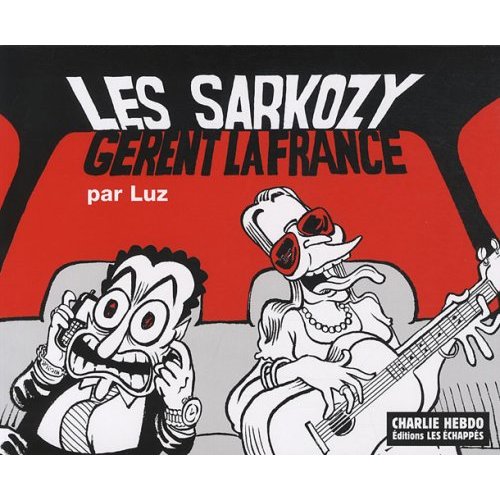 The history of French leadership meddling in the arts and culture has never been dull, and in the Baroque epoch may have contributed something of enduring value. Cardinal Richelieu was the supreme Machiavellian. However, he not only made France the greatest nation in the West but also fostered the flowering of the French genius. Today, the political dominance has evaporated, but French culture still hold high sway….
The history of French leadership meddling in the arts and culture has never been dull, and in the Baroque epoch may have contributed something of enduring value. Cardinal Richelieu was the supreme Machiavellian. However, he not only made France the greatest nation in the West but also fostered the flowering of the French genius. Today, the political dominance has evaporated, but French culture still hold high sway….
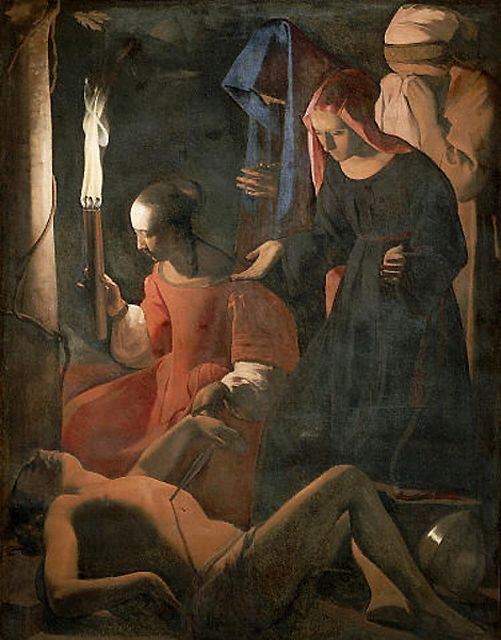
Richelieu's interest in the arts, particularly in the work of French artists led to a flurry of art patronage. George de la Tour : St. Sebastian. He pleased the king so much that the only painting in the royal bedchamber was a La Tour
Shortly before the death of Cardinal Richelieu, the dramatist Desmarets, who had once been Richelieu’s secretary, wrote an allegorical play that presents the foreign policy of Richelieu in the form of a romance. Expensively mounted, and acted out before a fashionable audience, the play showed the fair nymph Europa wooed by two lovers. The masterful Ibere ( Spain ) seeks to subdue her to his will. But the chivalrous Francion ( France ) asks only for the honor of protecting her and her numerous attndant nymphs, who represent the smaller nations.
When Ibere attempts to seize the lady by force, Francion draws his sword ”not only out of ambition, but out of necessity”. Victorious, he treats his enemies with great generosity. Figures representing Savoy,Mantua, and Lorraine are forgiven for helping the wicked Ibere, although Lorraine proves ungrateful and later deserts to the enemy.
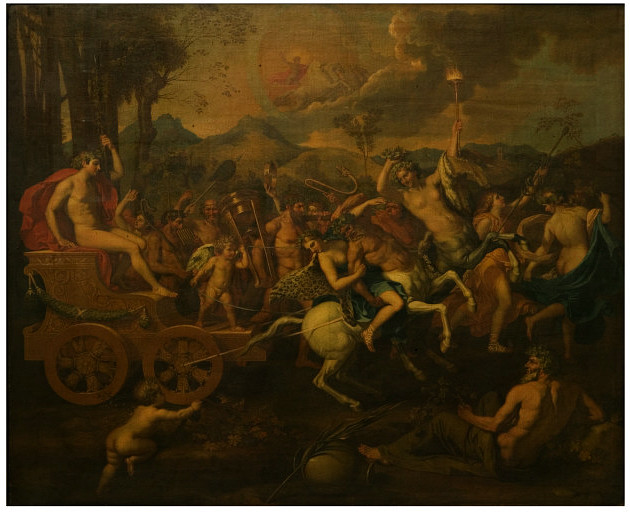
Poussin. The Triumph of Bacchus. Richelieu commissioned Poussin to paint two large canvases for the Chateau Richelieu including Bacchus. At the Cardinal's behest Poussin spent two years in Paris, but later returned to Rome where he found life more peaceful.
Neither Desmarets nor his play can be said to rank very high in the history of French literature. But the production of the allegorical drama is indicative of Richelieu’s attitude towards the arts. It was not only that they could be exploited as on this occasion, for propaganda purposes, but that a great and civilized nation ought to be great in literature, architecture, learning and the arts. It was the duty of rulers and their ministers to spend generously on these things and to stimulate and encourage their practice.
… ”Two million listeners tuned into Stéphane Guillon’s weekday 7.55am slots on France Inter, its equivalent of BBC Radio 4′s Today programme, in which he has savaged public figures, both Left and Right for the past two and a half years. Top political figures, including Mr Sarkozy, had been calling for his head for months, as they believe he has overstepped the mark between humour and insults. He says he has merely returned political satire to its rightful place in France, whose “bling” President he has thanked for single-handedly reviving the genre.”…
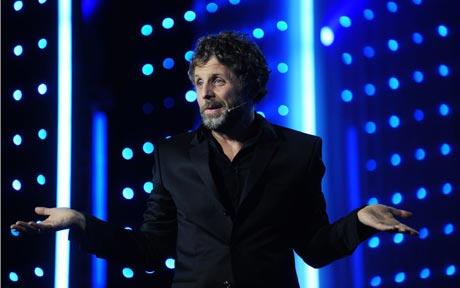
Stéphane Guillon: Mr Guillon's dismissal inevitably raised questions of political interference, as the head of Radio France ? the public radio group running seven public stations ? is directly nominated by Mr Sarkozy Photo: AFP
In the France of Richelieu the advantages of the Cardinal’s patronage outweighed the drawbacks. In literature, and especially in the theater, his influence had the most immediate and productive results. He had always been interested in drama, but like most educated men of his time he had little use for the crude and lively street theatres beloved by the people. He wanted to see French dramatic writing brought into line with the best classical models, and the French theatre a place of dignified entertainment for intelligent men and women.
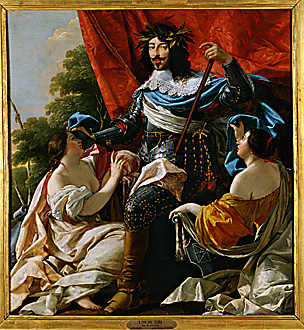
Simon Vouet. Louis XIII in an allegorical meeting with France L. and Navarre R. Vouet painted many portraits of the king, who was one of his pupils.
Actors and companies who sought to attract his attention exiled lewd jokes and horesplay from their performances, while playwrights turned to classical themes. Richelieu persuaded the king to authorize three permanent companies in Paris. He himsellf gave patronage and financial
p to several leading actors and dramatists.. He bestowed a pension on Mondory, the most famous actor manager of the time, whose fine voice and distinguished manners set a new tone for the french theatre. He built, within the precincts of his great palace in Paris, a magnificent theatre of his own. The queen, who attended the opening performance of this theatre, was served, presumably during the intermission with a collation of candied fruits in golden dishes.
There were many better dramatists than the aforementioned Desmarets, whose popularity is hard to fathom. There was tristan L’Ermite; there was the elegant and witty Mairet, to whom Richelieu also gave a pension. Above all, there was Pierre Corneille. Corneille’s ”Le Cid”, with Mondory in the title role, tok Paris by storm in 1637. Like many another play popular with the public, it ran afoul of the critics. The quarrel became so bitter that Richelieu intervened and commanded the newly founded Academy to judge the piece.
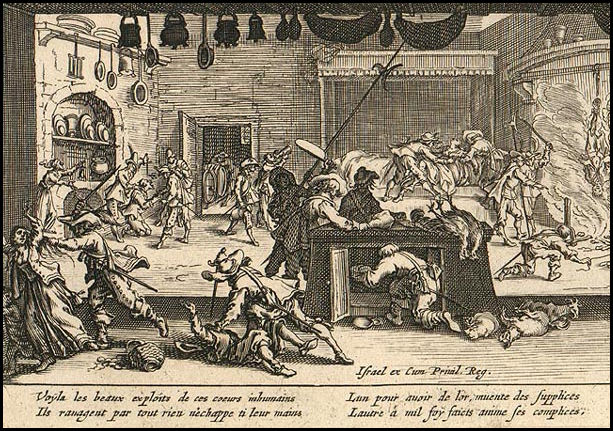
Jacques Callot, ''Les Miseres de la Guerre'' graphic evidence of what befell the peasant population in time of war.
… ”Mr Guillon’s dismissal inevitably raised questions of political interference, as the head of Radio France – the public radio group running seven public stations – is directly nominated by Mr Sarkozy, and the head of France Inter is a friend of the President’s wife. It comes days after Mr Sarkozy summoned the editor-in-chief of Le Monde to the Elysée and reportedly threatened to remove state aid if he sold the prestigious newspaper to a group of Left-wing businessmen.
Jean-Luc Hees, the head of Radio France, announced yesterday that Mr Guillon would not be returning to the airwaves after the summer break. He said: “Humour must not be confiscated by little tyrants.” Despite the huge audience figures, he said: “this comedy slot has been a failure” and was of “great intellectual poverty”. ”If humour is reduced to insults, I cannot tolerate it for others, nor for myself,” he said, saying Mr Guillon had “spat” on him in his sketches.” …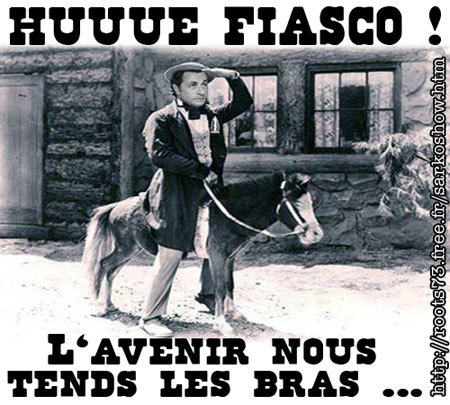
Corneille, like most writers of genius, was not bound by hard and fast aesthetic rules. The Academy, in due course reported that ”Le Cid” did not conform to the classical canon of playmaking and could not therefore be vindicated against its critics. Corneille was indignant, but Richelieu was determined to end the argument and forbade him to answer. The Academy,s condemnation and the Cardinal’s support of it are not to his credit. But if he did not admire ”Le Cid”, he admired much of Corneille’s work, gave him considerable encouragement, and bestowed gifts on him and his family. Corneille in return forgot his rancor over ”Le Cid” and dedicated to the Cardinal one of his finest plays, the classical tragedy ”Horace”.
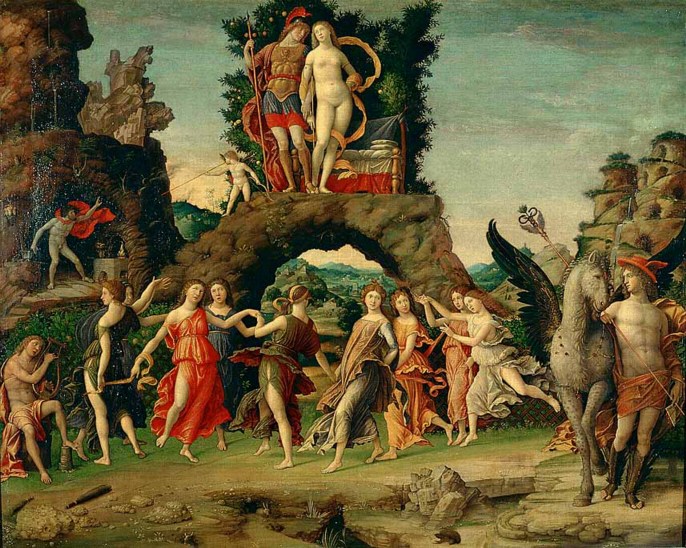
Andrea Mantegna. Parnassus.The nine muses...''The title of the painting is Mount Parnassus, a location said to be special to the Muses. We see them in the lower center, dancing in a circle while a male figure (perhaps the god Apollo or possibly Orpheus) plays the lyre on the left''
To be a member of the Academy, which was Richelieu’s conception, was, and has remained, one of the most coveted distinctions in the whole world of literature. The work that was done to stabilize French grammar and purify the vocabulary was of immense value. Thus was established that clear and flexible speech which replaced Latin as the international language of diplomacy and became the vehicle of the most influential modern literature in the world.
… ”The satirist’s first political run-in dates back to February last year, when he mocked Dominique Strauss-Kahn, the head of the International Monetary Fund, who had an affair with a colleague, as a compulsive womaniser – minutes before he entered the studio for an interview. Mr Guillon said that “exceptional measures” had been taken ahead of Mr Strauss Kahn’s arrival “in order not to awaken the beast”. These included “the banning of high heels and leather trousers” and a siren meaning “all female workers must be evacuated”….
Cardinal Richelieu loved architecture and the decorative arts no less than literature. He built the sumptuous Palais Cardinal in Paris whose majestic and opulent grandeur were outdone by his dream palace at Richelieu. Here in the little village of his childhood, he set out to create a new and noble city. The centerpiece was his own palace. Built by Lemercier, it was of majestic proportions. The facade was enriched with an array of statues, two of them by Michelangelo. Within, displayed among the rich furnishings, hangings and tapestries, were the finest pctures inhis collection; the lovely ”Parnassus” by Andrea Mantegna, looted for him from Mantua, along with other notable works of art. There were works by Durer and Perugino, Caravaggio, Titian and Leonardo da Vinci, as well as by the greatest of Richelieu’s French contemporaries, Poussin and Claude Lorrain. Richelieu never lived there and it was a melancholy sight. the town suffered from a lack of water and no one would live there. The building of it is the one inexplicable act of folly in the Cardinal’s career.
Richelieu would have liked to make Paris the aesthetic center of Europe, but the position was still in his time held by Rome. The two greatest French painters of the age, Poussin and Lorrain, had long been settled there, and Richelieu’s attempts to repatriate them met with no success. Poussin did come for a time, but was irritated by plans for redecorating the Louvre which did not give him enough scope. He soon decided that independence in Rome was preferable to the gilded cage of court patronage in France. His visit, however, put him in touch with new French patrons: if his pictures were not painted in France, many of them were now bought by French collectors.
… ”He was then criticised for calling Martine Aubry, the head of the Socialist party, a “fat little tobacco pot”. He has called Mr Sarkozy “a Lilliputian politician married six months out of 12″ and “Al Pacino, only more nervous”. Mr Sarkozy called him “insulting, vulgar, and nasty”. But his worst clash was with Eric Besson, the immigration minister who led the government’s controversial “national identity debate”. He called Mr Besson – who deserted the Socialists to join the Right-wing government – the “Mata Hari of French politics”, and a “weasel-eyed, chinless mole” for the far-Right National Front.” …
The two painters who dominated Paris in the time of Richelieu were the Flemish born Philippe de Champaigne and the Frenchaman Simon Vouet. The clear, astringent manner of Champaigne is in complete contrast to the rotund and flowing compositions of Vouet, but both were fearless colorists and fine decorative painters. Whatever Vouet’s intrinsic merit, he is significant because his studio in Paris became a center for young artists that competed with Italy and re-created a school of painting in France.
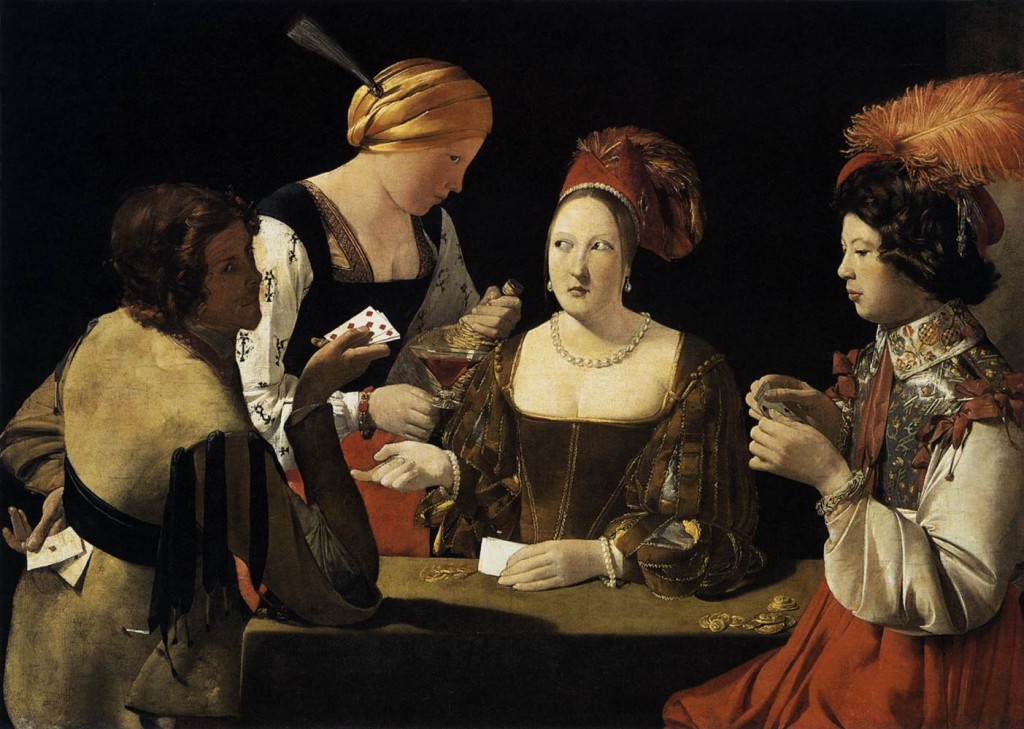
Georges de La Tour. Cheater with the Ace of Diamonds 1635 Oil on canvas, 106 x 146 cm Musée du Louvre, Paris
Two major French artists of the epoch, the engraver Jacques Callot and the painter Georges de La Tour, both came from Lorraine, at that time a province independent under its Duke. Richelieu employed Callot in the first years of his rule, but when the Duke of Lorraine persistently sided with the enemies of France, Callot as his loyal subject refused further commissions from Richelieu. The position of La Tour is harder to establish. His pictures of peasant subjects, highly valued today, would hardly seem of the kind to attract the Cardinal, but we know he had the title ”peintre de roi”, which indicates that he was within the circle of court patronage.
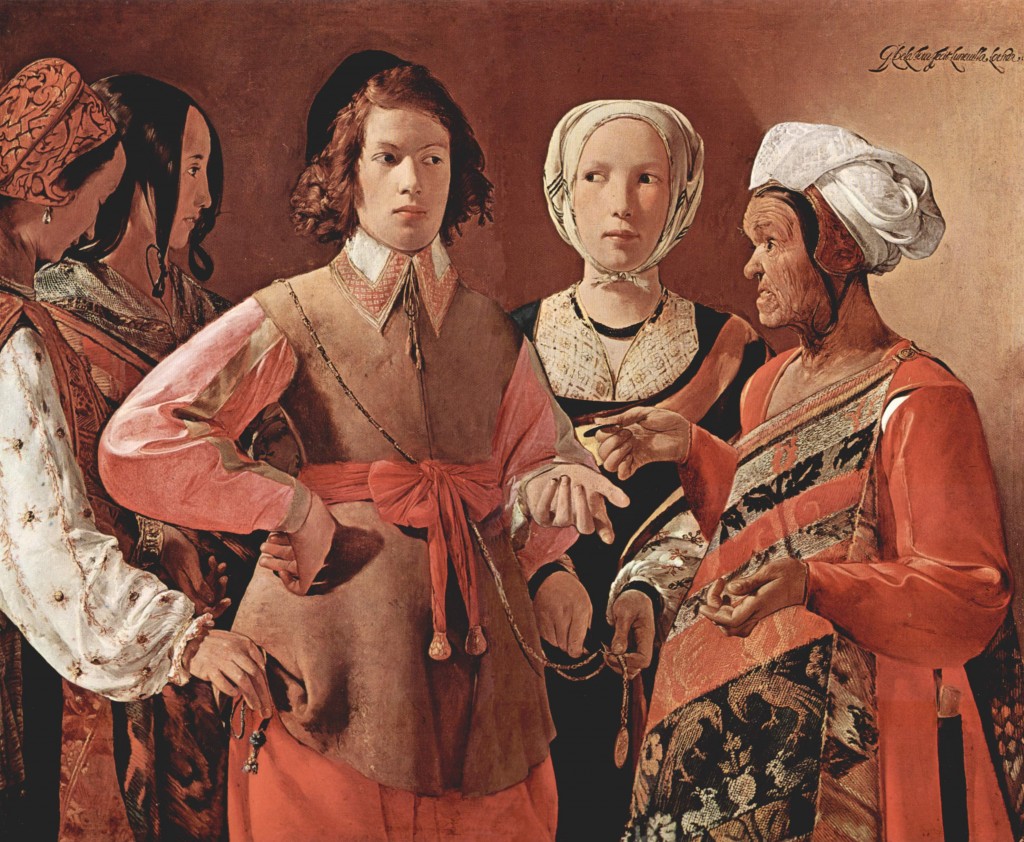
Georges de La Tour. ''The present painting catches a moment in which a young man of some wealth is having his fortune told by the old woman at right; she takes the coin from his hand, not only in payment, but as part of the ritual in which she will cross his hand with it. Most or all of the women portrayed are gypsies, and, furthering the stereotype of the time, they are depicted as thieves. As the young man is engrossed in the fortune-telling—an act which, if discovered, would have repercussions for both him and the gypsies—the leftmost woman is stealing the coin purse from his pocket, while her companion in profile has a hand ready to receive the loot. The pale-faced girl on the boy's left is less clearly a gypsy, but is also in on the act as she cuts a medal worn by the boy from its chain. The figures in the painting are close together, as if in a play, and the composition may have been influenced by a theatrical scene. The modern discovery of the painting is said to be traced to a French prisoner of war who viewed de La Tour's works in a monograph and found a likeness with a painting hung in a relative's castle.''
… ”France has enjoyed a boom in political satire since Mr Sarkozy’s election in 2007. Humorists have been spoiled for choice with his divorce, remarriage and penchant for millionaires’ yachts, not to mention the Rolexes, the jogging and “Carlamania”. Other comedians like Eric Canteloup are equally cutting but have a softer delivery. In his final sketch yesterday morning, Mr Guillon said: “Role up, role up, ladies and gentlemen, everything must go – total clear out of comedians. He was referring to a fellow humorist, Didier Porte, also fired from France Inter this week. ”France Inter, a Left-wing radio who fires like the worst Right-wing company,” he added ”…. ( Henry Samuel )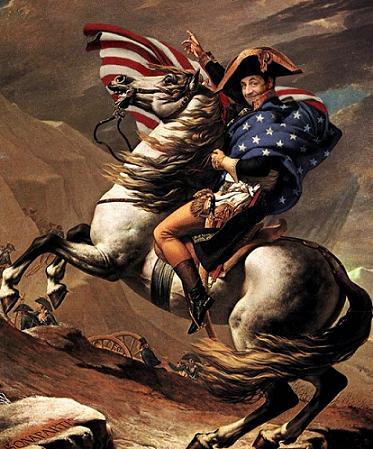
With regard to the comfort and happiness of the common people, the Cardinal was, like most rulers of his time, indifferent at best to their aspirations and generally aggressively hostile. He did not show much concern for the sufferings that his war policy caused to the unfortunate peasants on the frontier provinces. Taxes were high, and when harvests were bad, the poor suffered atrociously. Occasionally, they broke into revolt. Richelieu suppressed such revolts with an iron hand. Yet it can perhaps be accounted to his credit that he gave encouragement and support to that great Christian, Saint Vincent de Paul, whose work among the poor, the sick, and the outcast did something to alleviate the horrors of the age.
The personality of Richelieu is a bit of an enigma; a combination of devouring lust for power and devotion to duty. Though he lived in luxury, there was in his nature something austere and dedicated, marked by a seeming lack of human feeling. Perhaps because of this austere quality, this element of unworldliness in a man so worldly, that still hold a distance in our gaze upon him. The political power he built for France was ephemeral nonetheless. His greater glory was that he laid the foundations of her intellectual and aesthetic leadership.




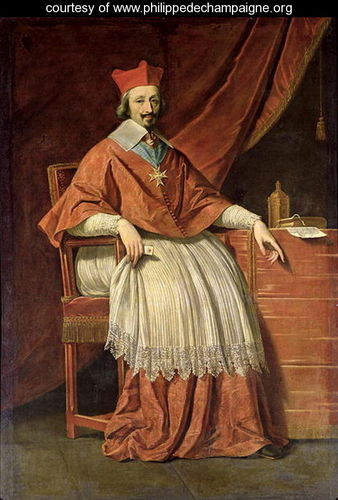
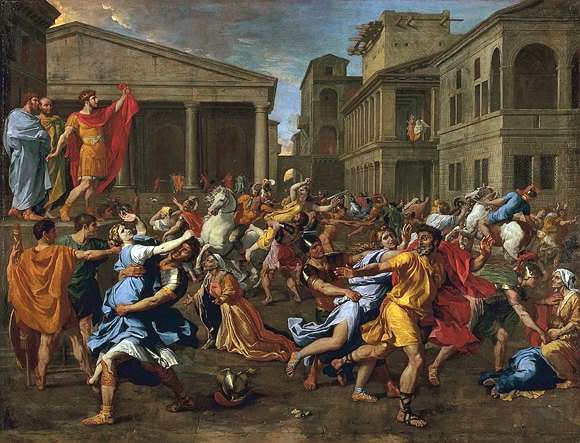
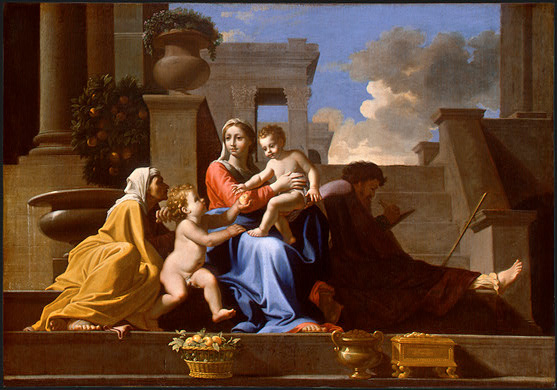
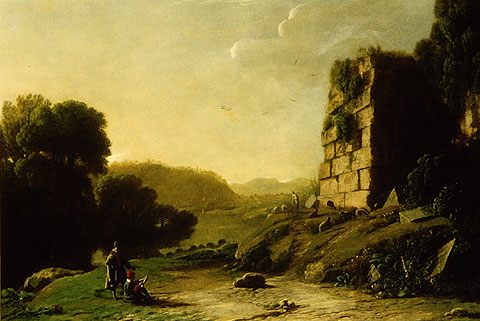




 COMMENTS
COMMENTS



